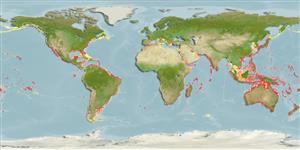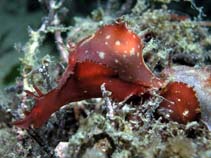Aplysia parvula Mörch, 1863
Little sea hare| Native range | All suitable habitat | Point map | Year 2050 |

|
| This map was computer-generated and has not yet been reviewed. |
| Aplysia parvula AquaMaps Data sources: GBIF OBIS |
Classification / Names Common names | Synonyms | CoL | ITIS | WoRMS
Gastropoda | Aplysiida | Aplysiidae
Environment: milieu / climate zone / depth range / distribution range Ecology
Benthic; depth range 0 - 50 m (Ref. 7727). Tropical
Distribution Countries | FAO areas | Ecosystems | Occurrences | Introductions
Circumglobal tropical, temperate seas and the Mediterranean Sea.
Length at first maturity / Size / Weight / Age
Maturity: Lm ? range ? - ? cm Max length : 19.0 cm TL male/unsexed; (Ref. 126605); max. published weight: 41.00 g (Ref. 126605); max. reported age: 1.00 years (Ref. 126605)
Sea hares have annual life cycles (Ref. 126605). Found roaming around various species of algae. A nocturnal species (Ref. 822). Common in intertidal and subtidal habitats to about 5 m in depth. A specialized herbivore and feeds largely on red algae (Ref. 866). Known from depths of 0 to 50 m (Ref. 7727); and from intertidal rock pools, and immediate subtidal on alga-covered reefs (Ref. 337). Also on seagrass (Ref. 109264).
Life cycle and mating behavior Maturity | Reproduction | Spawning | Eggs | Fecundity | Larvae
Members of the order Anaspidea are mostly simultaneous hermaphrodites.
Main reference
References | Coordinator | Collaborators
Burn, R. 2006. (Ref. 7727)
IUCN Red List Status (Ref. 130435)
CITES status (Ref. 108899)
Not Evaluated
CMS (Ref. 116361)
Not Evaluated
Threat to humans
Human uses
| FishSource |
Tools
More information
Age/Size
Growth
Length-weight
Length-length
Morphology
Larvae
Abundance
Growth
Length-weight
Length-length
Morphology
Larvae
Abundance
Internet sources
BHL | BOLD Systems | CISTI | DiscoverLife | FAO(Publication : search) | Fishipedia | GenBank (genome, nucleotide) | GloBI | Gomexsi | Google Books | Google Scholar | Google | PubMed | Tree of Life | Wikipedia (Go, Search) | Zoological Record
Estimates based on models
Preferred temperature
(Ref. 115969): 15.3 - 28.8, mean 26.7 (based on 1728 cells).
Price category
(Ref. 80766):
Unknown.



